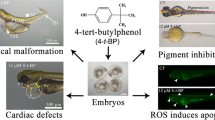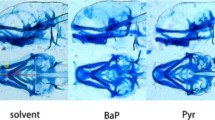Abstract
Polychlorinated biphenyls (PCBs) are ubiquitous environmental pollutants that may pose significant health-risks to various organisms including humans. Although the mixed PCB Aroclor 1254 is widespread in the environment, its potential toxic effect on heart development and the mechanism underlying its developmental toxicity have not been previously studied. Here, we used the zebrafish as a toxicogenomic model to examine the effects of Aroclor 1254 on heart development. We found that PCB exposure during zebrafish development induced heart abnormalities including pericardial edema and cardiac looping defects. Further malformations of the zebrafish embryo were observed and death of the larvae occurred in a time- and dose-dependent manner. Our mechanistic studies revealed that abnormalities in the arylhydrocarbon receptor, Wnt and retinoic acid signaling pathways may underlie the effects of PCBs on zebrafish heart development. Interestingly, co-administration of Aroclor 1254 and diethylaminobenzaldehyde, an inhibitor of retinaldehyde dehydrogenase, partially rescued the toxic effects of PCBs on zebrafish heart development. In conclusion, PCBs can induce developmental defects in the zebrafish heart, which may be mediated by abnormal RA signaling.








Similar content being viewed by others
References
Dolk H, Loane M, Garne E (2011) Congenital heart defects in Europe: prevalence and perinatal mortality, 2000 to 2005. Circulation 123:841–849. doi:10.1161/CIRCULATIONAHA.110.958405
Bruneau BG (2008) The developmental genetics of congenital heart disease. Nature 451:943–948. doi:10.1038/nature06801
Mone SM, Gillman MW, Miller TL, Herman EH, Lipshultz SE (2004) Effects of environmental exposures on the cardiovascular system: prenatal period through adolescence. Pediatrics 113:1058–1069
Pompa G, Caloni F, Fracchiolla ML (2003) Dioxin and PCB contamination of fish and shellfish: assessment of human exposure. Review of the international situation. Vet Res Commun 27(Suppl 1):159–167
Crinnion WJ (2011) Polychlorinated biphenyls: persistent pollutants with immunological, neurological, and endocrinological consequences. Altern Med Rev 16:5–13
Guvenius DM, Aronsson A, Ekman-Ordeberg G, Bergman A, Noren K (2003) Human prenatal and postnatal exposure to polybrominated diphenyl ethers, polychlorinated biphenyls, polychlorobiphenylols, and pentachlorophenol. Environ Health Perspect 111:1235–1241
Solomon GM, Weiss PM (2002) Chemical contaminants in breast milk: time trends and regional variability. Environ Health Perspect 110:A339–A347
Shen H, Main KM, Virtanen HE, Damggard IN, Haavisto AM, Kaleva M, Boisen KA, Schmidt IM, Chellakooty M, Skakkebaek NE et al (2007) From mother to child: investigation of prenatal and postnatal exposure to persistent bioaccumulating toxicants using breast milk and placenta biomonitoring. Chemosphere 67:S256–S262
Rogan WJ, Gladen BC, McKinney JD, Carreras N, Hardy P, Thullen J, Tinglestad J, Tully M (1986) Neonatal effects of transplacental exposure to PCBs and DDE. J Pediatr 109:335–341
Taylor PR, Lawrence CE, Hwang HL, Paulson AS (1984) Polychlorinated biphenyls: influence on birthweight and gestation. Am J Public Health 74:1153–1154
Wang YP, Hong Q, Qin DN, Kou CZ, Zhang CM, Guo M, Guo XR, Chi X, Tong ML (2012) Effects of embryonic exposure to polychlorinated biphenyls on zebrafish (Danio rerio) retinal development. J Appl Toxicol 32:186–193. doi:10.1002/jat.1650
Stainier DY (2001) Zebrafish genetics and vertebrate heart formation. Nat Rev Genet 2:39–48
Lam SH, Winata CL, Tong Y, Korzh S, Lim WS, Korzh V, Spitsbergen J, Mathavan S, Miller LD, Liu ET et al (2006) Transcriptome kinetics of arsenic-induced adaptive response in zebrafish liver. Physiol Genomics 27:351–361
Ung CY, Lam SH, Hlaing MM, Winata CL, Korzh S, Mathavan S, Gong Z (2010) Mercury-induced hepatotoxicity in zebrafish: in vivo mechanistic insights from transcriptome analysis, phenotype anchoring and targeted gene expression validation. BMC Genom 11:212. doi:10.1186/1471-2164-11-212
Hill AJ, Teraoka H, Heideman W, Peterson RE (2005) Zebrafish as a model vertebrate for investigating chemical toxicity. Toxicol Sci 86:6–19
Jones HS, Panter GH, Hutchinson TH, Chipman JK (2010) Oxidative and conjugative xenobiotic metabolism in zebrafish larvae in vivo. Zebrafish 7:23–30. doi:10.1089/zeb.2009.0630
Teraoka H, Dong W, Hiraga T (2003) Zebrafish as a novel experimental model for developmental toxicology. Congenit Anom 43:123–132
Gittenberger-de Groot AC, Bartelings MM, Deruiter MC, Poelmann RE (2005) Basics of cardiac development for the understanding of congenital heart malformations. Pediatr Res 57:169–176
Kwon C, Cordes KR, Srivastava D (2008) Wnt/beta-catenin signaling acts at multiple developmental stages to promote mammalian cardiogenesis. Cell Cycle 7:3815–3818
Niessen K, Karsan A (2008) Notch signaling in cardiac development. Circ Res 102:1169–1181. doi:10.1161/CIRCRESAHA.108.174318
Keegan BR, Feldman JL, Begemann G, Ingham PW, Yelon D (2005) Retinoic acid signaling restricts the cardiac progenitor pool. Science 307:247–249
Westerfield M (1993) The Zebrafish Book: a guide for the laboratory use of Zebrafish (Danio rerio) [M].Edition 4. Eugene OR: Univ. of Oregon Press
Kimmel CB, Ballard WW, Kimmel SR, Ullmann B, Schilling TF (1995) Stages of embryonic development of the zebrafish. Dev Dyn 203:253–310
Thisse C, Thisse B (2008) High-resolution in situ hybridization to whole-mount zebrafish embryos. Nat Protoc 3:59–69. doi:10.1038/nprot.2007.514
Chen JN, Fishman MC (1996) Zebrafish tinman homolog demarcates the heart field and initiates myocardial differentiation. Development 122:3809–3816
Yelon D, Horne SA, Stainier DY (1999) Restricted expression of cardiac myosin genes reveals regulated aspects of heart tube assembly in zebrafish. Dev Biol 214:23–37
Ohyama T, Mohamed OA, Taketo MM, Dufort D, Groves AK (2006) Wnt signals mediate a fate decision between otic placode and epidermis. Development 133:865–875
Park SS, Miller H, Klotz AV, Kloepper-Sams PJ, Stegeman JJ, Gelboin HV (1986) Monoclonal antibodies to liver microsomal cytochrome P-450E of the marine fish Stenotomus chrysops (scup): cross reactivity with 3-methylcholanthrene induced rat cytochrome P-450. Arch Biochem Biophys 249:339–350
Grimes AC, Erwin KN, Stadt HA, Hunter GL, Gefroh HA, Tsai HJ, Kirby ML (2008) PCB126 exposure disrupts zebrafish ventricular and branchial but not early neural crest development. Toxicol Sci 106:193–205
Yutzey KE, Rhee JT, Bader D (1994) Expression of the atrial-specific myosin heavy chain AMHC1 and the establishment of anteroposterior polarity in the developing chicken heart. Development 120:871–883
Rottbauer W, Wessels G, Dahme T, Just S, Trano N et al (2006) Cardiac myosin light chain-2: a novel essential component of thick-myofilament assembly and contractility of the heart. Circ Res 99:323–331
Ryckebusch L, Wang Z, Bertrand N, Lin SC, Chi X, Schwartz R, Zaffran S and Niederreither K (2008) Retinoic acid deficiency alters second heart field formation. Proceedings of the National Academy of Sciences of the United States of America 105: 2913–2918. doi:10.1073/pnas.0712344105
Lescroart F, Meilhac SM (2012) Cell lineages, growth and repair of the mouse heart. Results Probl Cell Differ 55:263–289. doi:10.1007/978-3-642-30406-4_15
Quaife NM, Watson O, Chico TJ (2012) Zebrafish: an emerging model of vascular development and remodelling. Curr Opin Pharmacol 12:608–614. doi:10.1016/j.coph.2012.06.009
Sisman T, Geyikoglu F, Atamanalp M (2007) Early life-stage toxicity in zebrafish (Danio rerio) following embryonal exposure to selected polychlorinated biphenyls. Toxicol Ind Health 23:529–536
Rochais F, Mesbah K, Kelly RG (2009) Signaling pathways controlling second heart field development. Circ Res 104:933–942
Puga A (2011) Perspectives on the potential involvement of the AH receptor-dioxin axis in cardiovascular disease. Toxicol Sci 120:256–261. doi:10.1093/toxsci/kfq393
Willert K, Nusse R (2012) Wnt proteins. Cold Spring Harb Perspect Biol 4:a007864. doi:10.1101/cshperspect.a007864
Mohamed OA, Clarke HJ, Dufort D (2004) Beta-catenin signaling marks the prospective site of primitive streak formation in the mouse embryo. Dev Dyn 231:416–424
Schneider VA, Mercola M (2001) Wnt antagonism initiates cardiogenesis in Xenopus laevis. Genes Dev 15:304–315
Panakova D, Werdich AA, Macrae CA (2010) Wnt11 patterns a myocardial electrical gradient through regulation of the L-type Ca(2+) channel. Nature 466:874–878. doi:10.1038/nature09249
Eisenberg CA, Eisenberg LM (1999) WNT11 promotes cardiac tissue formation of early mesoderm. Dev Dyn 216:45–58
Safe SH (1994) Polychlorinated biphenyls (PCBs): environmental impact, biochemical and toxic responses, and implications for risk assessment. Crit Rev Toxicol 24:87–149
Denison MS, Nagy SR (2003) Activation of the aryl hydrocarbon receptor by structurally diverse exogenous and endogenous chemicals. Annu Rev Pharmacol Toxicol 43:309–334
Acknowledgments
This work was supported by grants from the National Natural Science Foundation of China (Grant No. 30973213), the Key Medical Personnel Foundation of Jiangsu Province (Grant No. RC2011021), Nanjing Medical Science and Technique Development Foundation, and the Science and Technology Development Foundation of Nanjing Medical University (Grant No. 2011NJMU209).
Author information
Authors and Affiliations
Corresponding author
Additional information
M. Li and X. Wang have contributed equally to this study and they should be regarded as joint first authors.
Rights and permissions
About this article
Cite this article
Li, M., Wang, X., Zhu, J. et al. Toxic effects of polychlorinated biphenyls on cardiac development in zebrafish. Mol Biol Rep 41, 7973–7983 (2014). https://doi.org/10.1007/s11033-014-3692-6
Received:
Accepted:
Published:
Issue Date:
DOI: https://doi.org/10.1007/s11033-014-3692-6




